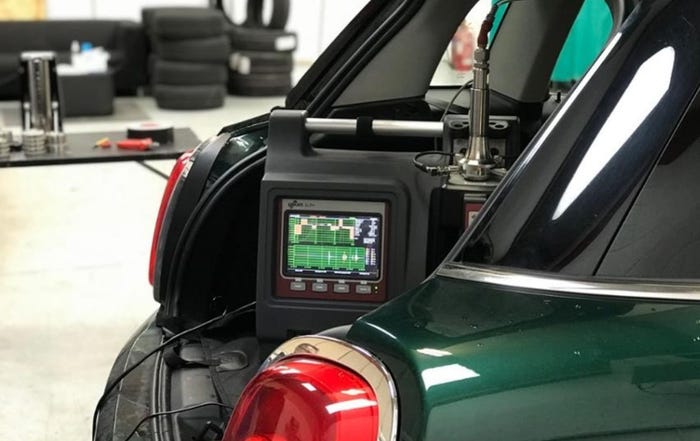Down to the WireSoftware tools leave bar napkins high and dry
Could the useful life of a bar napkin in conceptualizing a vehicle's electrical system be drawing to a close?Truly revolutionary ideas have emerged from crude sketches scrawled on the closest thing at hand when inspiration strikes at dinner or during drinks. But with today's advanced communication tools, suppliers and automakers must find better ways to trade critical product information.In the electrical

Could the useful life of a bar napkin in conceptualizing a vehicle's electrical system be drawing to a close?
Truly revolutionary ideas have emerged from crude sketches scrawled on the closest thing at hand when inspiration strikes at dinner or during drinks. But with today's advanced communication tools, suppliers and automakers must find better ways to trade critical product information.
In the electrical systems business, new software is arriving with potential to not only simplify that interaction but also slice development time by more than half.
"This has cut down on our overtime and our engineering tasks," says John Banks, principal engineer at wiring leader UT Automotive. "No longer are we chasing scrap pieces of paper or bar napkins. In the past, trading this information was chaotic. Now it's centralized and consistent."
Mr. Banks refers to a system from Mentor Graphics that will generate a wiring schematic for all or part of a vehicle based on a three-dimensional image created on a CATIA work station.
The schematic can include every electrical or electronic function, from audio systems to headlamps. Simulations can be run to detect any open circuits or misconnections and to determine if the wiring gauge and fuses are adequate.
"Previously, you would hand-draw these schematics, and you put your faith in your drafting department," Mr. Banks says. "Now, software tools are giving it to you electronically."
UTA started using the Mentor Graphics/CATIA system two years ago, and it reduced development time (normally about 135 weeks) by 57% in a recent bumper-to-bumper wiring job for DaimlerChrysler Corp.
The biggest change, Mr. Banks notes, is that the wiring schematic is created once, and changes made to it electronically are seen by all engineers working on it, both at the OEM and supplier level. In the past, the supplier and customer usually had their own schematics, which meant each company had to alter their models when design changes were made. Once again, a phone call or a bar napkin drawing did not always constitute effective communication.
"Now, everyone can be on the same page," Mr. Banks says. In addition, routing throughout the vehicle becomes easier, data input is simpler, and supplier databases of their work can be much more complete.
Anything that simplifies automotive wiring is a blessing as consumers demand the conveniences of home when on the road. Power locks, for instance, used to be a luxury. Now, more than 80% of U.S.-built cars have them.
Virtually all features contributing to safety and comfort today require power, from sunroofs and auto-dimming mirrors to trip computers and remote keyless entry. If on-board navigation systems and Internet access gain wide acceptance, vehicle wiring systems will become even more complex.
The average vehicle a few years ago had about 75 lbs. (34 kg) of wiring, all of it stretching more than a mile. There's so much wiring - with more coming in the future - that the auto industry is migrating from the current 12-volt standard to 42 volts for additional capacity.
"You will have more wires than ever before, and you'll have to trace them all through the body and make sure they're hooked up properly," says Ken Waichunas, director of automotive marketing for software supplier Analogy Inc.
He sees automakers pushing for smaller gauge wires to carry the same amount of power, which will require a redesign of electrical systems.
New design tools can contribute to these efforts.
Late last year, Analogy won a contract to supply AB Volvo with its new SaberHarness, a $25,000 software package that can be used to design, simulate and test a wiring system before manufacturing it. The entire system can be validated before a single prototype is built.
Volvo will use SaberHarness to replace its in-house development tools, for both passenger cars and heavy trucks. Analogy is expecting to announce another major automotive customer for Saber-Harness in the coming months, Mr. Waichunas says.
Another giant in electrical systems, Yazaki Corp., which invented the wire harness concept in 1929, has been using Analogy simulation tools for several years and has tested SaberHarness recently.
"It's a truly powerful tool," says Ray Ernst, manager of advanced technology at Yazaki North America Inc.
What he likes most is that designers can use the package to describe the functions they want in the vehicle, and the software does the rest.
"It will tell you automatically what your gauge sizes have to be," Mr. Ernst says. "That all used to be done by hand by the engineer."
Despite the excitement about these new tools, apparently some of them cannot build an electrical schematic that allows multiple features (for instance, a vehicle with and without power windows) to be plugged in and out.
Analogy's Mr. Waichunas says SaberHarness can do it. But UTA's Mr. Banks says he needs to be convinced.
About the Author
You May Also Like





